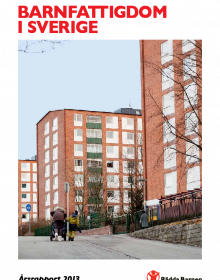
Reports
Barnfattigdom i Sverige. Årsrapport 2013
Publication year:
2013
Swedish
Format:
pdf (2.4 MiB)
Publisher:
Save the Children Sweden
According to Save the Children Sweden’s (SCS) latest report on child poverty in Sweden, 232,000 children lived below the poverty line in 2011 (12,1%), which constitutes a decrease of 0.6 percentage points compared to a year earlier (10,000 fewer children). This year’s report shows an overall decline in child poverty rate between 2010 and 2011, evenly distributed among Swedish municipalities. A positive step forward is that many municipalities are acting on their commitment to reduce the impact of child poverty.
The report highlights that those children at greatest risk of poverty or social exclusion are children living with a lone parent or children from migrant backgrounds. Today, nearly one in three children (29,8%) with a foreign background lives in poverty in Sweden, compared to 5,5% of children whose parents were born in Sweden. Taken together, the picture becomes clearer: 53,7% children in single parent homes with a foreign background live in income deprived households, compared to only 2,1% percent of children who come from homes with two Swedish-born parents. Economic vulnerability among children varies substantially between municipalities and, particularly in the larger cities (Stockholm, Gothenburg and Malmö), also within the municipalities. Although the economic situation for children is worse in the largest cities, the majority of all economically vulnerable children live in the suburban areas of these cities. Malmö is the city with the highest child-poverty rate among Sweden’s 290 municipalities, with 30% of the children living under the poverty line, although the latest data show a reduction at the same percentage rate as in the rest of the country.
Child poverty in Sweden is seldom about children going hungry or being cold because their parents cannot afford to buy them food or clothes. More often, it is about children from low income families who forgo events that most children would take for granted. This report describes child poverty as a living standard that is too low for a child to participate in all school/out-of-classroom activities that schools organise (school trips, visits and events), with all the equipment, transport expenses and clothing required for these activities. SCS measures child poverty as a child who lives in a family with a low income standard, i.e. the income in the family is not enough to cover necessary expenses, or as a child who lives in a family receiving financial aid from the social services.
SCS has worked against child poverty in Sweden since 2002. The main activity has been to produce annual reports on the child poverty situation and recent trends in the country.
Read full abstract
Authors
View & Download
Swedish
1 Documents
Document information
Publisher
Authors
Format
Content type
Country
Region
Topics
Rights
© Author/Publisher
Found a mistake? Help us improve!
If you have noticed a document assigned to the wrong author or any other inaccuracies, let us know! Your feedback helps us keep our data accurate and useful for everyone.
Share
Link
